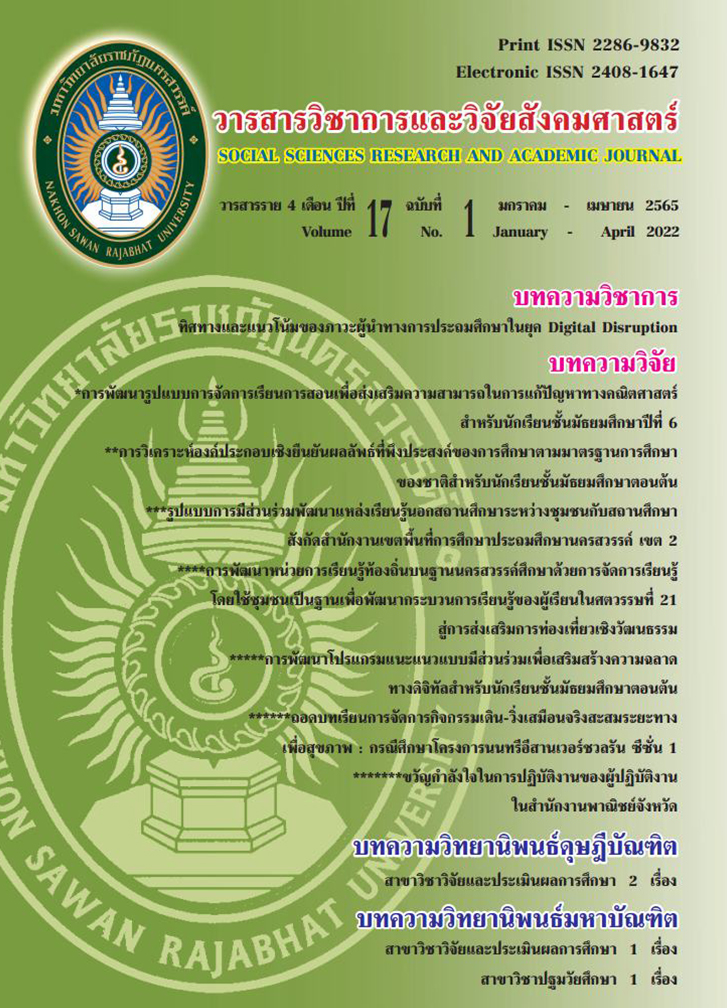การวิเคราะห์องค์ประกอบเชิงยืนยันผลลัพธ์ที่พึงประสงค์ของการศึกษาตามมาตรฐานการศึกษาของชาติสำหรับนักเรียนชั้นมัธยมศึกษาตอนต้น Confirmatory Factor Analysis of Desired Outcomes of Education based on the National Educational Standards for Lower Secondary School Students
Main Article Content
Abstract
บทความวิจัยนี้เป็นส่วนหนึ่งของงานวิจัยเรื่อง การวิเคราะห์ผลลัพธ์ที่พึงประสงค์ของการศึกษาตามมาตรฐานการศึกษาของชาติสำหรับนักเรียนชั้นมัธยมศึกษาตอนต้น โดยมีวัตถุประสงค์เพื่อตรวจสอบความสอดคล้องกลมกลืนของโมเดลองค์ประกอบผลลัพธ์ที่พึงประสงค์ของการศึกษาตามมาตรฐานการศึกษาของชาติสำหรับนักเรียนชั้นมัธยมศึกษาตอนต้นกับข้อมูลเชิงประจักษ์ กลุ่มตัวอย่าง คือ นักเรียนชั้นมัธยมศึกษาตอนต้น จังหวัดปทุมธานี จํานวน 600 คน ได้มาจากการสุ่มแบบหลายขั้นตอน เครื่องมือที่ใช้เป็นแบบสอบถามชนิดมาตรประมาณค่า 5 ระดับ มีความตรงเชิงเนื้อหาโดยได้ค่าดัชนีความสอดคล้องระหว่างข้อคำถามกับนิยามเชิงปฏิบัติการอยู่ในช่วง .80 ถึง 1.00 ค่าความเที่ยงของแบบสอบถามเท่ากับ 0.973 วิเคราะห์ข้อมูลโดยใช้สถิติเชิงบรรยายและการวิเคราะห์องค์ประกอบเชิงยืนยันอันดับสอง ผลการวิจัยพบว่า ผลลัพธ์ที่พึงประสงค์ของการศึกษาตามมาตรฐานการศึกษาของชาติสำหรับนักเรียนชั้นมัธยมศึกษาตอนต้น ประกอบด้วย 3 องค์ประกอบ ได้แก่ องค์ประกอบที่ 1 การเป็นผู้เรียนรู้ ประกอบด้วย จํานวน 5 ตัวบ่งชี้, องค์ประกอบที่ 2 การเป็นผู้ร่วมสร้างสรรค์นวัตกรรม ประกอบด้วย จํานวน 5 ตัวบ่งชี้ และ องค์ประกอบที่ 3 การเป็นพลเมืองที่เข้มแข็ง ประกอบด้วย จํานวน 3 ตัวบ่งชี้ และมีความกลมกลืนกับข้อมูลเชิงประจักษ์ พิจารณาจากค่าดัชนีความสอดคล้องกลมกลืน คือ 2 = 58.326 (df = 43, p = .059), 2/df = 1.356 , CFI = .998, GFI = .985, AGFI = .969, RMSEA = .024 และ SRMR = .013 แต่ละองค์ประกอบมีค่าน้ำหนักองค์ประกอบมาตรฐานอยู่ในช่วง .937 ถึง .992 แต่ละตัวบ่งชี้ขององค์ประกอบหลักมีค่าน้ำหนักองค์ประกอบมาตรฐานอยู่ในช่วง .583 ถึง .923
This research article is part of the research entitled Analysis of Desired Outcomes of Education based on the National Educational Standards for Lower Secondary School Students. The purposes of this study was to validate the fitness of desired outcomes of education based on the national educational standards for Lower secondary school students and using empirical data. Samples consisted of 600 Lower secondary school students in Pathum Thani province, selected by multi-stage random sampling. The data were collected using a questionnaire, 5-point rating scale. The content validity of the questionnaire ranged from .80 to 1.0 based on an index of item objective congruence. The reliability of the questionnaire was .973. The data were analyzed by using descriptive statistics and second- order confirmation factor analysis (CFA). The research findings showed that the desired outcomes of education based on the national educational standards for Lower secondary school students consisted of three factors, i.e., learner person comprised of five indicators, innovative co-creator comprised of five indicators, and active citizen comprised of three indicators, which were consistent with the empirical data: 2 = 58.326 (df = 43, p = .059), 2/df = 1.356 , CFI = .998, GFI = .985, AGFI = .969, RMSEA = .024 and SRMR = .013. The standardized factor loading of each factor ranged from .937 to .992, and the standardized factor loading of each indicator ranged from .583 to .923
Article Details
References
กระทรวงศึกษาธิการ. (2563). การจัดการเรียนรู้ฐานสมรรถนะเชิงรุก. นนทบุรี: 21 เซ็นจูรี่.
พรชนิตว์ ลีนาราช. (2560) .ทักษะการรู้ดิจิทัลเพื่อพัฒนาคุณภาพการเรียนรู้. วารสารห้องสมุด, 61(2), 76-92.
วิชัย วงษ์ใหญ่, และมารุต พัฒผล. (2562). การพัฒนาทักษะสร้างสรรค์นวัตกรรม. กรุงเทพฯ: ศูนย์ผู้นำนวัตกรรมหลักสูตรและการเรียนรู้.
สุภมาส อังศุโชติ, และคณะ. (2554). สถิติการวิเคราะห์สําหรับการวิจัยทางสังคมศาสตร์และพฤติกรรมศาสตร์: เทคนิคการใช้โปรแกรม LISREL. (พิมพ์ครั้งที่ 3). กรุงเทพฯ: เจริญดีมั่นคงการพิมพ์.
สำนักงานเลขาธิการสภาการศึกษา. (2561). มาตรฐานการศึกษาของชาติ พ.ศ. 2561. สืบค้นเมื่อ 10 มิถุนายน 2564, จากhttp://qa.vru.ac.th/pdf/2560/%E0%B9%83%E0%B8%8A%E0%B9%89%E0%B8%A5%E0%B8%87%20Diary%20%E0%B8%AA%E0%B8%81%E0%B8%A8.(06-12-61).pdf.
สำนักงานเลขาธิการสภาการศึกษา. (2562ก). มาตรฐานการศึกษาของชาติ พ.ศ. 2561. นนทบุรี: 21 เซนจูรี่.
สำนักงานเลขาธิการสภาการศึกษา. (2562ข). รายงานผลการวิจัยแนวทางการนำมาตรฐานการศึกษาของชาติสู่การปฏิบัติ. กรุงเทพฯ: สำนักมาตรฐานการศึกษาและพัฒนาการเรียนรู้ สำนักงานเลขาธิการสภาการศึกษา
สำนักงานเลขาธิการสภาการศึกษา. (2563). มาตรฐานการศึกษาของชาติกับการประกันคุณภาพการศึกษาของคนไทย. นนทบุรี: 21 เซนจูรี่.
Diamantopoulos, A., & Siguaw, J. A. (2000). Introducing LISREL: A guide for the uninitiated. London: Sage.
Ebel, R. L. (1965). Measuring educational achievement. New Jersey: prentice–Hall.
Erkuş, A. (2003). Psikometri üzerine yazılar. Ankara: Türk Psikologlar Derneği Yayınları.
Gagne, P., & Hancock, G. R. (2006). Measurement model quality, sample size, and solution propriety in confirmatory factor analysis. Multivariate Behavioral Research, 41(1), 65–83.
Hair, J. F., Black, W. C., Babin, B. J., & Anderson, R. E. (2010). Multivariate Data Analysis: A Global Perspective. (7th ed.). New Jersey: Prentice Hall.


